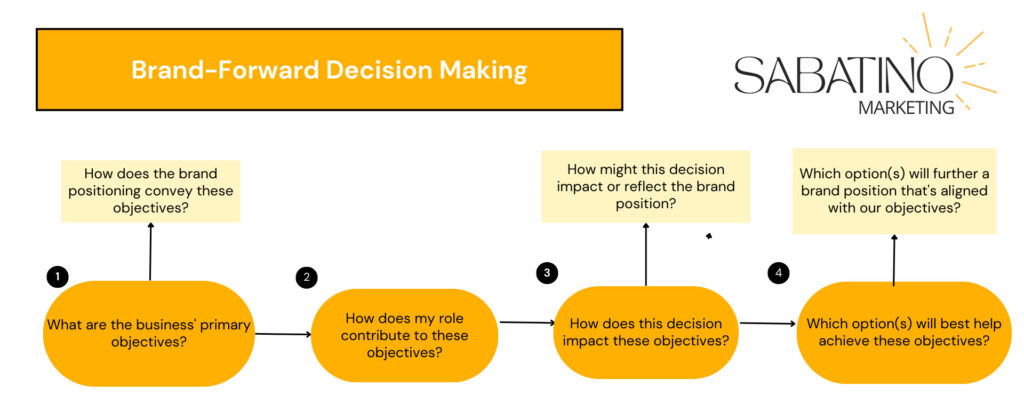the
Practical advice on building strategy, reflections on marketing trends and more.
Blog

Whether you’re the CEO, a director, a marketing team member or a customer service rep, you are making decisions every day that impact your business’ brand, or, the brand perception. Pausing to ask yourself a series of questions before making decisions about products, processes, growth, investments, technologies or even how to handle a particular interaction, can help keep you oriented to your businesses’ main purpose and your brand’s core message.
What is Brand-Forward Decision Making?
Choosing to reflect closely on how each decision you make impacts your business’ core objectives and works to build the brand is adopting brand-forward decision-making. With almost any business decision, you can walk through a series of questions to evaluate your options on the basis of how it will impact the business and the brand. Let’s break it down into steps.

Questions to Guide Decision-Making
The key questions and you want to ask at the start of any project or decision point are:
- What are the business’ primary objectives?
- How does the brand present those objectives?
- How does my role contribute to those objectives?
- How does this decision play a role in those objectives?
- How does this decision reflect/impact the brand?
- Which option(s) best contribute to achieving those objectives?
- Which option(s) will further a brand that’s aligned with our objectives?
The first question and its counterpart are meant to orient you, to set your north star. To remind you of your “why” and “how.”
Next, examining what your role-specific priorities are can help identify biases you may have toward certain options and/or make clear what information you are bringing to the decision.
The third question and its counterpart asks you to connect back the dilemma or decision at hand to the main objectives of the brand and business so you can understand clearly its importance.
Lastly, you’re ready to evaluate the options before you and decide which is the right one for the business (and it’s brand!)
Try it!
Examples of the Process at Work
Here are two examples of how you might use this approach to handle simple business decisions.
EXAMPLE 1
Dilemma: How to spend some residual marketing budget
Options: Purchase a billboard or buy/distribute customer appreciation t-shirts
Questions:
What are the business’ primary objectives? Are we in a brand-build stage? Do we need to raise more awareness? Are we focused instead on retaining and increasing our customer base?
How does the brand position convey these objectives? How else are we showing up in the market? What are most of our marketing efforts focused on? Does our messaging focus on brand awareness/education or does it speak to people further down the funnel?
How does my role contribute to those objectives? If I work in marketing, my main objective may be to show measurable results or increase brand perception overall. If I work in customer service, I may be more concerned about enhancing current consumer experience. If I’m the CEO, I may be focused on growth as well as retention.
How does this decision play a role in those objectives? Spending money on one objective means less funding for another; forces prioritization of awareness or retention/lead acquisition. One is short term high impact, one is longer term slower impact.
How does this decision reflect/impact the brand? Choosing an option that aligns with the existing marketing strategy OR introduce a new tactic presents an opportunity either to double-down OR to test something new. Neither one is better than the other, but they are different.
And finally, you can ask: Which option(s) best contribute to achieving those objectives? AND Which option(s) will further a brand that’s aligned with our objectives?
EXAMPLE 2:
Dilemma: How to address a rising customer service demand
Options: Outsource to a third party or hire additional in-house representatives
What are the business’ primary objectives? We need to meet the customer service need, but are we most interested in high efficiency/speed, or high quality, personalization? What kind of customer service aligns with our business model?
How does the brand position convey these objectives? Based on the brand we’ve built, what do our customers expect from customer service? Are we a “big” brand or a “mom and pop”? Are we fast and consistent or trustworthy and individual-focused?
How does my role contribute to those objectives? If I work in marketing, my main objective may be to control brand perception overall. If I work in customer service, I may be more concerned about enhancing current consumer experience and keeping track of patterns. If I’m the CEO, I may be looking to increase efficiency and save costs.
How does this decision play a role in those objectives? If our objective is the best possible customer service, we need to define what that looks like first. Quality/personalization and efficiency may both be possible with outsourcing, but it’s not guaranteed. In home customer service provides a level of control/quality and personalization you won’t get outsourcing, but it costs time and money to manage internal teams.
How does this decision reflect/impact the brand? Good or bad customer service can make or break word of mouth branding.
And finally, you can ask: Which option(s) best contribute to achieving those objectives? AND Which option(s) will further a brand that’s aligned with our objectives?
Brand-Forward Decision Making
December 28, 2023
Hi! I'm Colleen.
I’m a strategic marketing professional with over a decade of experience and a passion for mission-based brands.
full bio
founder
marketing consultant communication expert
founder | marketing consultant | communication expert
I’m also a trained writer who loves teaching people and organizations how to improve their communication to achieve their goals. Part marketing leader, part communications instructor, 100% focused on YOUR growth.